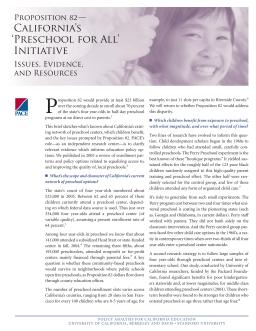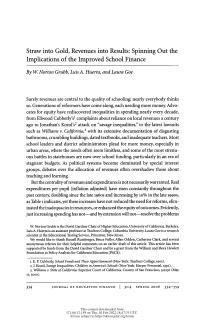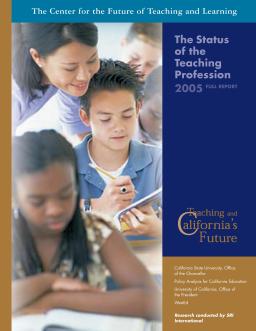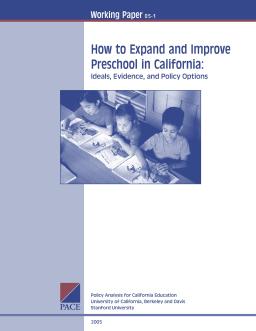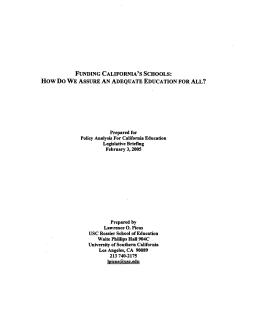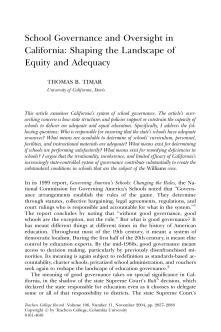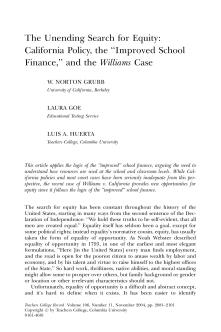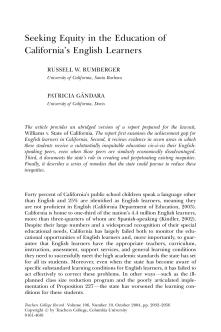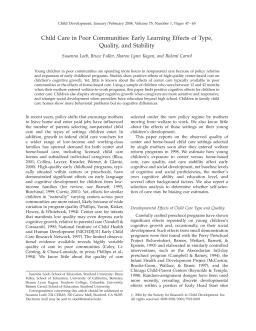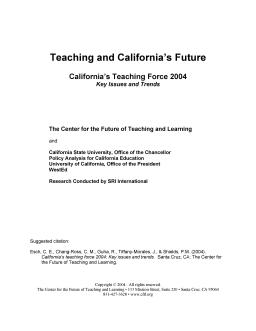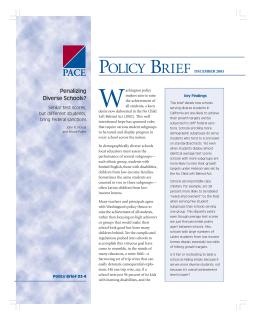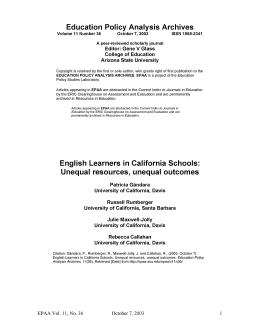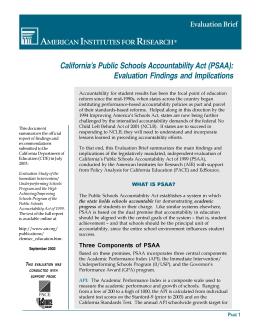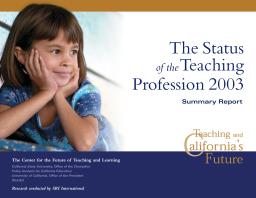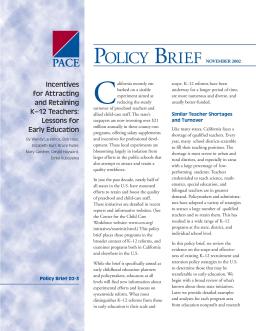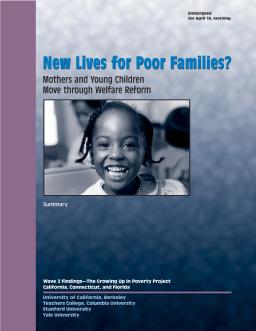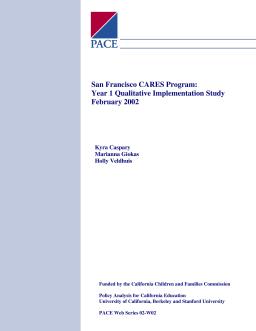Issues, Evidence, and Resources
Published
Summary
This policy brief provides an overview of California's existing network of preschool centers and the potential impact of Proposition 82, which would provide funding for half-day preschool programs for 70% of the state's four-year-olds. PACE, an independent research center, aims to clarify evidence informing education policy options. A 2005 PACE review focused on enrollment patterns and policy options for improving access and quality of local preschools.
Spinning Out the Implications of the Improved School Finance
Published
Summary
Despite the belief that increased spending leads to better educational outcomes, real expenditures per pupil have doubled since the late 1960s, yet problems in schools persist. An improved school finance approach focuses on effective resources in schools and classrooms that improve valued outcomes, rather than just increasing spending. Clarifying why funding is often wasted and developing new models of connections between revenues, resources, and the results of schooling is essential.
The Reliability of How States Track Achievement
Published
Summary
This working paper analyzes the impact of the No Child Left Behind Act on the state's funding system and notes that it exacerbated inequities by penalizing schools that did not meet annual progress targets without providing sufficient resources to help them improve. The authors suggest that a more equitable funding system based on student needs and costs would better serve all students, including those who are struggling to meet academic standards.
Full Report
Published
Summary
The Teaching and California's Future initiative provides policymakers with data on the teacher workforce and labor market. The initiative's annual report details teacher development policies and their impact on teacher quality and distribution. The goal is to help policymakers make informed decisions about strengthening the state's teacher workforce.
Published
Summary
The quality of teaching and the need to expand California's ranks of excellent teachers demand urgent public discussion. We must attract the best and brightest to teaching, prepare them effectively, and support and retain them. Solutions require bipartisan leadership, not spin. This report presents the latest research and projections, highlighting that while some numbers are improving, we're likely to face severe shortages again soon and the pipeline for recruiting, preparing, and training teachers has substantial problems.
PACE Research and Policy Options
Published
Summary
PACE researchers are studying the effects of early care and education in California and nationwide, working with the Language Minority Research Institute. We also are illuminating policy alternatives and evidence that advocates might consider. Here is an infographic listing related and relevant publications.
Ideals, Evidence, and Policy Options
Published
Summary
Many California children benefit from preschooling, but enrollment rates are lower for poor and working-class families. Quality is uneven, and policy makers must address key questions regarding expanding and improving preschooling, including who should benefit and who should pay, who should operate it, how to improve quality, and how to structure it for diverse families. Evidence can inform policy options, which stem from differing ideals about preschooling. Nationwide evidence is considered in this review.
How Do We Assure an Adequate Education for All?
Published
Summary
California ranks 44th in the nation in education spending, spending only 86.1% of the national average per pupil in 2001-02. The recession of the early 2000s resulted in dramatic budget deficits for the state and substantial reductions to the expected level of school funding. Research suggests using the concept of adequacy to estimate the costs of providing an educational program that will enable all—or almost all—children to meet the state's high proficiency standards and offers recommendations for finding additional resources needed to adequately fund California's schools.
Published
Summary
The National Education Association (NEA) and the American Federation of Teachers (AFT) initially remained neutral on the No Child Left Behind Act (NCLB). Though both organizations have similar criticisms of the law, the AFT has taken a more thoughtful and less predictable approach, while the NEA has focused on public denunciation. However, neither organization has been entirely successful in crafting a policy response to NCLB.
Shaping the Landscape of Equity and Adequacy
Published
Summary
This report focuses on California's school governance system and how it affects schools' ability to provide an adequate and equal education. The author examines who is responsible for ensuring adequate resources, how to assess adequacy, how to determine school performance, and how to address deficiencies. The report argues that California's state-controlled governance system is irrational, incoherent, and limited in efficacy, contributing to substandard school conditions, as seen in the Williams v. California case.
California Policy, the "Improved School Finance," and the Williams Case
Published
Summary
This article applies the logic of the ‘‘improved’’ school finance, arguing the need to understand how resources are used at the school and classroom levels. While California policies and most court cases have been seriously inadequate from this perspective, the recent case of Williams v. California provides new opportunities for equity since it follows the logic of the ‘‘improved’’ school finance.
Published
Summary
This article presents a summary of a report prepared for the Williams v. State of California lawsuit, highlighting the achievement gap for English learners in California and seven areas where they receive an inequitable education compared to their English-speaking peers. It also documents the state's role in perpetuating these inequities and proposes remedies to reduce them.
Early Learning Effects of Type, Quality, and Stability
Published
Summary
This report examines the effects of center care and home-based care on cognitive and social development of young children in poor communities, as well as the impact of caregiver sensitivity and education level. The study used a sample of children whose mothers entered welfare-to-work programs and found positive cognitive effects for children in center care, and stronger cognitive and social development for those with more sensitive and educated caregivers. However, children in family child care homes showed more behavioral problems.
California’s Teaching Force, 2004—Key Issues and Trends
Published
Summary
California's aging teacher workforce will lead to a significant demand for teachers, with shortages particularly in special education and secondary education. The number of underprepared teachers in low-performing schools serving minority, poor, and ELL students is disproportionate. Budget cuts have reduced funding for recruitment and professional development programs, and California's induction system needs refinement. Curriculum-based professional development programs have mainly targeted elementary school teachers, neglecting the training needs of secondary teachers.
Similar Test Scores, but Different Students, Bring Federal Sanctions
Published
Summary
California schools with more demographic subgroups are less likely to meet their growth targets and face federal sanctions, even when students have similar average test scores. Schools with many low-income Latino students are particularly unlikely to hit growth targets. Is it fair to label diverse schools as failing when their overall achievement level is not necessarily lower?
Published
Summary
Modern statecraft in education is giving way to unmodern policy and institutional reform, favoring small and communal schools, alternative networks, and cultural pluralism. Charter schools and preschooling illuminate this shift toward de-centering education, while posing the long-term challenge of balancing particular forms of schooling against the modern impulse to integrate groups via large institutions.
Unequal Resources, Unequal Outcomes
Published
Summary
This article discusses the inequitable education provided to English language learners in California, arguing that there are seven areas where these students receive an inferior education compared to English speakers. That includes having less qualified teachers, inferior curriculum, and being assessed with invalid instruments. The article provides suggestions for addressing these issues.
Evaluation Findings and Implications
Published
Summary
This report evaluates California's Public Schools Accountability Act of 1999, which aimed to hold schools accountable for student results. The brief summarizes the main findings and implications of the legislatively mandated, independent evaluation of the Act, with the aim of helping states understand and learn from preceding accountability efforts.
Summary Report
Published
Summary
This report argues that the state of California needs to prioritize better education for all children with a sustained long-term investment of resources and leadership. Despite political upheaval and fiscal problems, there is a consensus for better education. The authors suggest that the issue requires a response as intense and sustained as the state's response to natural disasters, and calls for a system of teacher development to ensure all teachers have the necessary knowledge and skills to meet academic standards.
Which Families to Serve First? Who Will Respond?
Published
Summary
This paper discusses extending access to preschool for families in California, focusing on targeting priorities to yield strong enrollment demand and discernible effects on young children's early development and school readiness. It analyzes different targeting mechanisms and suggests experimenting with alternative expansion strategies, rather than investing exclusively in one method. The report also describes which communities would benefit most and considers the criteria for judging the wisdom of targeting options.
Assessing Balance and Substance
Published
Summary
Arnold Schwarzenegger received lopsided media attention during the first weeks of his campaign, according to a UC study. 87% of the 164 stories reported by the New York Times focused on Schwarzenegger. Less coverage was given to Bustamante, who was out-polling the actor at the time. The study found little coverage of policy issues and that Schwarzenegger’s personal history and character received more attention. Lesser-known candidates, including Peter Camejo and Arianna Huffington, received proportionally less coverage.
Lessons for Early Education
Published
Summary
This policy brief discusses state initiatives in the US aimed at retaining and improving the quality of preschool and childcare staff, with a focus on California's $21 million annual investment. While K-12 reforms have been underway longer and are usually better-funded, early childhood education policymakers and educators will find valuable information about experimental efforts and lessons on systemwide reform.
Mothers and Young Children Move Through Welfare Reform
Published
Summary
This report discusses the lack of knowledge about the impact of welfare-to-work programs on young children since 1996, and how policy leaders are debating ways to aid jobless mothers and enrich their children's lives. The project team followed 948 mothers and preschool-age children for two to four years after the women entered new welfare programs in California, Connecticut, and Florida.
Mothers and Young Children Move Through Welfare Reform: Executive Summary
Published
Summary
This report examines how welfare-to-work programs have affected the lives of young children since 1996, and how they've impacted the home and childcare settings in which they are raised. The study followed 948 mothers and preschool-age children in California, Connecticut, and Florida for two to four years, using interviews, assessments, and visits to homes and childcare settings. The report highlights the major findings from the study.
Year 1—Qualitative Implementation Study
Published
Summary
This report on San Francisco County’s CARES program (SF CARES) provides guidance for policymakers, program administrators, and childcare advocates planning similar initiatives. PACE collected feedback from program planners, stipend recipients, and other childcare community members on aspects of the planning and implementation process. SF CARES successfully distributed over 400 stipends in the program’s first year, but challenges remain in reaching a broader array of childcare providers and communicating program goals.
